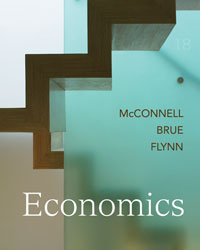Economics (McConnell), 18th EditionChapter 36:
Current Issues in Macro Theory and PolicyWorked Problems <a onClick="window.open('/olcweb/cgi/pluginpop.cgi?it=jpg::::/sites/dl/free/0025694212/384254/wp_icon_20.jpg','popWin', 'width=NaN,height=NaN,resizable,scrollbars');" href="#"><img valign="absmiddle" height="16" width="16" border="0" src="/olcweb/styles/shared/linkicons/image.gif"> (19.0K)</a>
Problem 36.1 - Equation of exchange <a onClick="window.open('/olcweb/cgi/pluginpop.cgi?it=jpg::::/sites/dl/free/0025694212/384254/wp_icon_20.jpg','popWin', 'width=NaN,height=NaN,resizable,scrollbars');" href="#"><img valign="absmiddle" height="16" width="16" border="0" src="/olcweb/styles/shared/linkicons/image.gif"> (19.0K)</a>
Problem 36.1 - Equation of exchange
Problem: Suppose an economy's nominal GDP is $5000 billion and the money supply is $1000 billion. - What is velocity of money in the economy?
- Suppose the velocity is constant and equal to the value just computed. If the money supply increases by 2%, what do you predict will happen to nominal GDP?
| Answer: - The equation of exchange states that MV = PQ where M is the money supply, V is velocity, and PQ is price times output, or nominal GDP. Rearrange this equation to find that V = PQ/M. In this economy, V = $5000/$1000 = 5.
A 2% increase implies a new money supply of 1.02 x $1000 = $1020 billion. This value multiplied by the velocity, 5, gives the new level of nominal GDP. Nominal GDP will rise to $1020 x 5 = $5100 billion.
|
 | 




